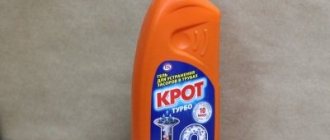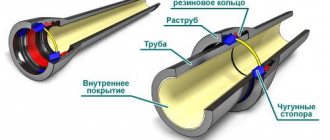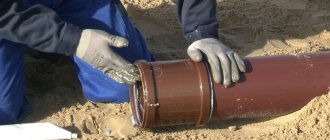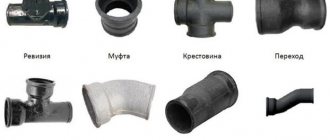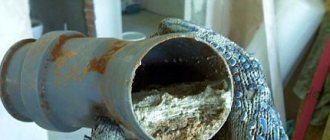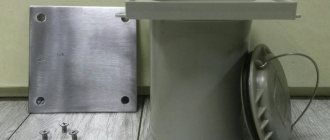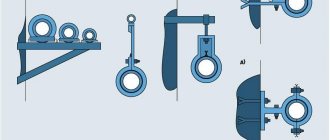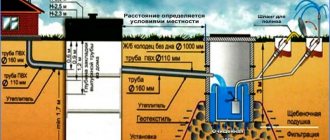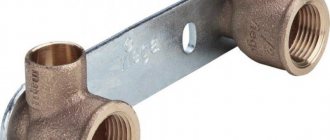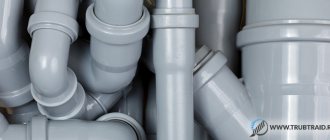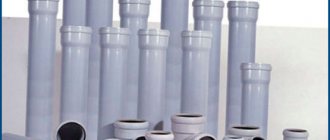Let's look at plastic sewer bends 110 - sizes and types, what they are and what characteristics they have - more details in this article!
A modern sewerage system is a complex engineering structure, the main part of which is occupied by pipelines. When creating a system, different types and sizes of pipes are used, but they are all sold in the form of straight sections. If it is necessary to change the direction or connect one pipeline line to another, special fittings are needed that have a certain shape and size. There are a large number of similar elements. The most common are plastic sewer bends 110, the dimensions of which are optimal for most pipelines. Let's take a closer look at this issue.
Features and purpose
A sewer fitting is a special device made in the form of a socket, the sleeves of which can be positioned relative to each other at different angles and have different cross-sectional diameters. The inlet part of the tee is made in the form of a pipe, the edges of which are rolled, and the other two parts are equipped with sockets into which sewer pipes of suitable diameter are inserted.
To ensure maximum tightness, the tees are equipped with special rubber sealing rings that can serve without replacement for 20 years.
The role of tees in the sewerage system can hardly be overestimated: with their help, the angle of inclination of the pipes changes, as well as their spatial direction. In addition, fittings play an important role in connecting pipes of different diameters to each other, which contributes to the formation of a single sealed pipeline system. The parts are widely used in the installation of sewerage systems in buildings and structures for any purpose; they are used for the arrangement of drainage sewers, the construction of septic tanks, drainage and water drainage systems, as well as for connecting washing machines and dishwashers.
Among the advantages of tees are low cost, wide consumer availability, resistance to corrosion processes, ease of installation and long service life, reaching 50 years. The disadvantages include the large weight of cast iron specimens and some difficulties during their installation.
When arranging a sewer system, several types of connecting fittings are used, differing in size, configuration and functional purpose.
- Straight tees. The fittings have a right angle of inclination and are designed to connect horizontal and vertical water pipes. This type of fittings is the most common and is used in almost all sewer systems.
- Angled tees. They differ in an inclination angle of 45 degrees and are used for piping in toilets, bathrooms and kitchens. The advantage of these fittings is the complete absence of risk of clogging due to the absence of problem areas.
- Revision couplings. They are a type of tees and serve to control the sewer system, and, if necessary, to clean it. Models are equipped with a special screw-on valve, which is located on an additional outlet, and allows you to quickly penetrate the system and clean it using a cable. Couplings are installed in problem areas that have complex transitions and are most susceptible to clogging.
Based on the cross-sectional sizes, tees are classified into equal-bore and unequal-bore. The first are characterized by the same diameter of all sockets and are used to connect pipes of the same size. The latter are distinguished by different sections of the inlet part and pipes, and are widely used for sewerage plants in apartments and private houses. This is due to the fact that the diameter of internal networks is usually 50 mm, while external ones reach a size of 110 mm.
The fittings also differ in the method of fastening. Traditional reducing tees are equipped with a press sleeve and a nut, while combination models have an internal thread or are equipped with a union nut. The diameter of the pipes is also varied.
In addition to standard sections, the most common of which are 50, 110 and 160 mm, there are tees of quite large sizes, with a diameter of 400 to 500 mm.
Easy assembly thanks to the use of special connecting elements
Sewers built using PVC pipes and connecting elements are characterized by a number of advantages, including:
- affordable price;
- light weight;
- unrelated corrosion resistance;
- long service life without the need for regular cleaning;
- ease of installation work.
Speaking about the modern plastic waste disposal system, I would like to especially note such a level of quality as ease of installation. Installation is really simple and this is made possible thanks to the use of special connecting elements - fittings.
Main varieties
When constructing domestic sewer systems, three main types of connecting tees are used, which differ in configuration and are intended to perform certain specific functions.
- Sewer tees at 87° or 90° - the main purpose of this part is to connect a vertical riser to horizontal sections of the pipeline.
- 45° Sewer Tees - These connectors are used to secure plastic pipes in the construction of most horizontal branches.
- The revisions are a coupling with a perpendicularly located outlet, which is closed with a removable cover . As the system is used, the cover may be removed to inspect the degree of blockage or to clear the blockage.
The listed varieties are quite sufficient to form a complete household wastewater disposal system. But in order to count on success in installation, it is necessary to take into account the standard sizes of these connecting elements and their compliance with the standard sizes of the pipes.
Tees, in accordance with the diameter of the pipe connection, can have the following cross-sectional sizes: 110 mm, 160 mm, 200 mm, 250 mm and 315 mm. For the needs of constructing industrial systems with higher throughput properties, connecting elements with cross-sectional diameters of 400 mm and 500 mm are manufactured.
In addition, the dimensions of the 110 mm sewer tee and other modifications may not be uniform in all directions. For example, the sections of horizontal pipes can be uniform, while a vertical or diagonal outlet can have a smaller or larger diameter.
Structural highlights
Regardless of the size and configuration, the design of a polymer tee is simple. The outlet part of the product is made in the form of a simple pipe with rolled edges. Two inlet parts, for example 50 by 50 mm, are equipped with special sockets into which the ends of pipes of suitable diameter enter.
For high density, tightness and reliability of the connection, the sockets have special rubber sealing rings. According to statements from manufacturers of polyvinyl chloride pipes and related accessories, a correctly installed connection will last at least 20 years without the need to replace the seal.
Rules for installation work
The instructions for carrying out installation work using plastic tee connections are characterized by ease of implementation and can be fully done with your own hands.
Pipeline installation will be successful if you adhere to the following recommendations:
- When constructing horizontal wiring, we use only tees with a 45-degree bend.
It is fundamentally important: If tees with a perpendicular connection are used when constructing horizontal distributions, the possibility of frequent blockages of the sewer system during subsequent operation significantly increases.
- The ends equipped with a socket must be directed towards the starting higher point of the network. Thus, the socket should function as an entrance to the connecting element, while the pipe end should act as an exit.
- Rubber sealing rings cannot be trimmed or generally removed. The seal is intentionally inserted so that the connection is as tight and airtight as possible; therefore, one should not be surprised that certain efforts have to be made during installation.
Tip: To simplify the task, it is enough to lubricate the inner surface of the joined elements with a soap solution before installation. In this case, the pipes will fit into the socket much easier, and the required joint density will be achieved.
- It is advisable, and in some cases necessary, to fasten areas of connection of wiring elements with a diameter of more than 50x32 mm to the adjacent surface using bracket holder clamps.
- Installation of inspections must be carried out in sections of the pipeline with free access. In most cases, such elements are generally not used in a private home or are installed in limited quantities.
Materials
The manufacture of sewer tees is made from various materials. In addition to the popular polymer models, fittings made of metal, ceramics and asbestos cement are also widely used and have a certain demand. Such parts are used to connect pipes made of the same materials, in accordance with GOST requirements. Thus, for cast iron systems, it is allowed to use tees made strictly in accordance with GOST 6942-1469, which is explained by the peculiarities of the connection and operation of these pipelines.
The type of connection depends on what material the fitting is made of. For example, for ceramic and asbestos-cement tees only socket connections are allowed, while for other types threaded and socketless connections can be used.
The above tees have a fairly narrow specialization, so the most common and purchased are plastic models made of PVC, which, in turn, are divided into products made of polyethylene (HDPE) and polypropylene (PP).
- The HDPE tee is designed for use in a free-flow sewer system and allows you to connect and branch pipes without welding. The fitting is manufactured by casting and subjected to special machining. The connection to the pipes is made using compression couplings equipped with clamps, which significantly reduces the time required for work and simplifies installation. The limitation in using this connection method is pressure systems through which the liquid passes under high pressure and can break the clamp.
- The PP tee is used in almost all sewerage systems and is characterized by high resistance to high and low temperatures, as well as overall strength. The fitting can be connected with a socket and is compatible with all types of pipes. An important nuance when installing polypropylene models is their ability to expand, which occurs upon contact with hot liquid. Therefore, when installing a pipe inside the socket, you need to leave a gap of 1 cm. For ease of installation, a mark is placed on the fitting indicating how far the pipe should extend.
Plastic tees differ in the degree of permissible load, which is indicated by the color of the product. Thus, gray models have a softer single-layer structure and are characterized by increased thermal conductivity. This allows you to discharge hot water at a temperature of up to 60 degrees into the system without fear for the reliability of the connection of the tee to the pipeline. Red fittings are designed for installation in external networks and are characterized by increased resistance to weight and mechanical loads. This allows them to easily withstand movement and heaving of soil, as well as the impact caused by the movement of people and vehicles.
Plastic sewer bends 110, sizes and types
Let's look at plastic sewer bends 110 - sizes and types, what they are and what characteristics they have - more details in this article!
A modern sewerage system is a complex engineering structure, the main part of which is occupied by pipelines. When creating a system, different types and sizes of pipes are used, but they are all sold in the form of straight sections. If it is necessary to change the direction or connect one pipeline line to another, special fittings are needed that have a certain shape and size. There are a large number of similar elements. The most common are plastic sewer bends 110, the dimensions of which are optimal for most pipelines. Let's take a closer look at this issue.
What are sewer outlets
A sewer outlet is a system element made in the form of a piece of pipe with a changing direction, or with an additional connecting pipe. The most common type is a section of curved pipe with a connecting coupling (socket) at one end. There are also designs that are a straight section of pipeline with two couplings. One of them is located on a straight section, and the second is attached in the middle at a right angle or at 45°. The first type of fitting is called a double; it performs the function of changing the axial direction of movement of the drains. The second type is a tee. In fact, this is a splitter capable of performing different functions and tasks. There are different types of sewer outlets that fully comply with the nomenclature of the main pipelines and can be connected to the corresponding pipes directly or through a special adapter.
Initially, they were cast iron shaped castings, the installation of which was a rather difficult task. They were connected by hermetically filling the socket with cement mortar or a special composition of sanitary sulfur. Modern elements are made of plastic; they are devoid of almost all the disadvantages of cast iron pipes and fittings. Their main advantage is the smooth inner surface, which does not create areas for the settling of fat deposits and blockages.
Useful tips
When designing a sewer system, it is recommended to use bends of the same type. If this is necessary, you can turn to the use of special adapters, which will make it possible to combine any components. If it is necessary to connect massive pipe structures, special segment-type bends should be used. When designing a sewer system, a large number of joints and rotary joints should be avoided, since such areas can cause leaks.
The most popular are bends, the inside of which has a smooth surface. Effluent flows through such parts much easier and faster. PVC parts boast such characteristics, which makes them more relevant than metal options. Sewer pipes need to be additionally insulated when it comes to low temperatures. Typically, materials such as polystyrene foam, polystyrene foam or mineral wool are used for this. In addition to sealant, the joints of sewer outlets can be treated with compounds such as bitumen mastic, resin, technical sulfur or a special sealing tape.
In the next video you will see the installation of plastic sewer pipes.
What are they needed for
The main task of sewer branches is to ensure the rotation of the sewer pipeline at a certain angle, or to organize the connection of one line to another.
There are different types of sewer tees or twins that allow you to organize any change in the system configuration. Any plumbing fixture is connected to the sewer bed using an appropriate tee inserted into the gap in the pipeline. The deck chair itself is also connected to the sewer riser by installing a 110 mm tee.
The standard dimensions of the sewer tee 110 allow you to connect it to the riser, provide connection to the toilet flush, or use it in other parts of the system. If it is necessary to rotate the line in any direction - in the vertical or horizontal plane, doubles are used.
When creating a project, sharp turns of pipelines should be avoided. It is recommended to refuse even 90° turns at once, installing two 120° bends in succession. This will reduce the risk of waste accumulation and clogs.
To eliminate mistakes, you need to have a fairly complete understanding of what sewer pipes and outlets there are. This will allow you to select the most effective and safe elements and organize a smooth system configuration without sudden turns. A diagram or drawing of the sewer network, where all directions are visible and dimensions are indicated, will provide significant assistance in this. The diagram immediately shows the most problematic areas of the system that require making the necessary amendments.
Where to start?
It is advisable to begin any work with drawing up a plan. Especially if this work involves such precise diagrams as utility lines.
Let's consider the main stages of preparation.
- First you need to draw up a detailed diagram of the future system, estimating where the water discharge points will be located.
- Having such a diagram, it will be easy to imagine where the fittings will need to be installed, what types of fasteners will be needed, and it will also be possible to clarify the required length of pipes.
- Work always begins from the lowest point of entry into the sewer. This is due to the fact that it is from this point that the pipes slope. Since, in most cases, a gravity-flow system is planned, the installation of sewer pipes is carried out on a slope; for every meter of pipe, one centimeter of slope is planned. It is convenient to install pipes using a building level.
- The pipes must be assembled so that the socket is directed upward.
Types and sizes
Cast iron pipelines are still found in older houses. The elbows used in such systems are also made of cast iron. They are heavy, difficult to install and require highly qualified plumbers. Today they are practically not used, although such elements are still on sale.
Modern sewer outlets are made from different types of plastic:
- PVC;
- polypropylene;
- low or medium pressure polyethylene.
All pipes, regardless of material, are fully compatible with each other. This means that the dimensions of PVC sewerage outlets are no different from the parameters of shaped elements made of polypropylene or polyethylene. This is convenient for installation or repair work. The most common pipelines with a diameter of 50 mm (internal sewerage laid to the toilet) and 110 mm (toilet tee and the rest of the system, including the riser). Sometimes the markings indicate a diameter of 100 mm. It must be borne in mind that these are the same pipes with a diameter of 110 mm.
There are different types of sewer twins. They are shaped elements, the difference between which is their diameter and angle of inclination. The most common types of bends for sewer pipes 110 by angle: 15°;
- 15°;
- 30°;
- 45°;
- 67°;
- 87°.
The types of tees for sewerage are very diverse. They can be divided according to the following characteristics:
- diameter;
- number of taps;
- bend angle;
- functional purpose.
The diameter of the fittings corresponds to the dimensions of the main pipelines. The most common tees for sewer pipes are 110, the types of which correspond to all possible functional tasks. At the same time, larger elements can be used for the outer part of the sewer:
- 125 mm;
- 150 mm;
- 160 mm;
- 200 mm;
- 250 mm;
- 300 mm, etc.
Types of parts
Variety of sewer outlets
Bends for creating sewage systems are classified according to many characteristics:
- material;
- size;
- configurations;
- connection method.
Turns and 90-degree corner connections are called bends; parts that provide a connection angle of 30 or 45 degrees are considered half-bends.
To assemble a single system from parts of different diameters, special adapters are used to eliminate leaks at the joints. They are sold on the market under the name “socket restorer”.
Material of manufacture
In the manufacture of plumbing outlets, various materials are used, which have advantages and disadvantages. Products made of plastic: polypropylene, polyvinyl chloride have become widespread. Old-built houses are equipped with cast iron sewerage.
Products made from these materials do not require the use of any electrical devices during installation. It’s easy to assemble a single structure with your own hands; for connection, one end is made in the form of a socket, and the other in the form of a smooth pipe with a taper.
Installation of polyethylene parts will require the use of special soldering stations. A heating wire is mounted in the wall of the fitting. After joining the parts, voltage is applied to the spiral, it heats up and fuses the components. Such sewer systems are done “once and for all.” The configuration of communications can only be changed by dismantling and subsequent soldering of new connections.
Size of fittings
For internal sewerage of residential buildings, the most popular sizes of pipes and, therefore, branches for them are considered to be products with internal diameters from 40 to 110 or 150 mm.
Plastic bends (polypropylene and polyvinyl chloride) are unified and supplied to the retail network mainly with diameters of 40, 50, 110, 150 mm. For drainage from a washing machine, you can purchase pipes and fittings for them with a cross-section size of 25 mm; the bathtub and dishwasher can be connected to drains with an internal passage of 40 mm. For risers, pipes 110 or larger are used, equipped with bends of 110 and 50 mm.
Cast iron sewer outlets have a nominal internal passage of 65 mm, while the pipe itself is produced with an outer diameter of 81 mm. For risers, a pipe with an internal diameter of 100 mm and an external diameter of 118 or 125 and 144, respectively, is used.
Configuration of fittings
Types of sewer outlets can be seen in the catalogs of any company that produces plumbing systems. The list of products includes:
- one- and two-plane crosspieces;
- tees;
- bends and half-bends;
- audits;
- bends with reduction, where a smaller one is connected to the main pipe of a larger diameter;
- bottles - transitions from a smaller diameter to a larger one.
Tees for sewer pipes: types and installation instructions
Today it is impossible to imagine comfort and convenience in a private home without a sewer system. Of course, in order to install a sewerage system in a private house, you will need many details, among which tees for sewer pipes occupy a special place.
They are special devices used to create certain branches in the pipeline system in a private house, cottage, apartment or any administrative buildings.
These created branches facilitate the transportation of wastewater or fecal matter. The parts themselves have a bell-shaped design, which, in fact, ensures ease and simplicity of connections with plastic pipes, or with each other.
They can have a right angle, or they can have an angle of 45 degrees. As a rule, tees have a service life of 50 years and provide ultra-reliable installation.
The content of the article:
This is what a tee for sewer pipes looks like
Plumbing pipe fitting
Tees are shaped products designed for quick and easy installation of sewerage systems.
Their tasks include:
- connections of sewer pipes of the same or different diameters (possibly connecting sections of pipelines made of different materials);
- branching sewer pipelines, organizing complex configuration systems;
- creating connection points for various plumbing fixtures (how to make soundproofing of a sewer riser in an apartment building with your own hands, read here);
- providing opportunities for simple and quick maintenance of pipelines, including removing blockages.
What types of tees are there?
The sewer tee is a very important element that ensures the branching of the pipeline.
Today there are several types of connecting tees:
- PVC tees are straight, designed for sewer pipes at 90/87 degrees. This type of tee is used to connect vertical risers to the horizontal part of the sewer system;
PVC Straight Tee
45 degree tee
This is what an inspection tee with a coupling and cover looks like
The most modern and convenient are plastic devices for branching the pipeline system.
In addition, replacing a plastic tee is much easier, since it can be done without the use of improvised tools, and this greatly simplifies the repair process.
The main advantages of plastic tees include:
Tee for plastic pipes
- durability;
- ease of installation;
- affordable price;
- reliability of the design.
Thanks to this type of fitting, it is possible to connect pipes and make a branching of the pipeline, which will ensure the unhindered flow of wastewater into different parts of the sewer system.
Routing pipes using a plastic tee
Advantages of internal sewage system made of uPVC:
- long-term operation;
- reliability and strength;
- resistance to environments with a high degree of aggression;
- the smooth inner surface does not create conditions for the formation of blockages;
- maintainability and ease of replacement of a section that has worn out for any reason;
- fire resistance – the ignition temperature of PVC is 380°C;
- are difficult to ignite and do not support the combustion process;
- installation of fire-prevention couplings required when installing polypropylene sewerage is not required;
- optimal flexibility ratio;
- relatively light weight;
- reasonable cost;
- Possibility of integration with other sewer systems.
Produced nomenclature:
In our company you can buy PVC pipes for internal sewerage with a diameter of 50 mm, a thickness of 1.8-3.2 mm and 110 mm, a thickness of 2.2-3.2 mm.
Possible pipe lengths – 0.5; 1; 1.5; 2; 3m.
The range of shaped products for internal sewerage is presented:
- PVC bends;
- PVC tees;
- single-plane PVC crosspieces;
- two-plane PVC crosspieces
- PVC sliding repair couplings;
- PVC couplings;
- PVC gearboxes;
- PVC revisions;
- plugs for PVC socket;
- PVC compensation pipes.
How to install a tee on a PVC sewer pipe
PVC tees for sewer pipes can be used for both internal and external sewerage.
You can consider how to install a tee on a sewer pipe using the example of connecting a sink and toilet:
- first of all, you need to place the toilet in its designated place in the toilet and mark the place where you plan to install the tee;
- then the toilet needs to be removed from its future location or simply put aside;
- using sealant, the tee should be inserted into the socket of the riser;
An example of installing a tee for connecting to a toilet
This is how sealant is applied to connect a toilet
This is what a toilet connected to a corrugated tee looks like
For example, if you need to make only one branch from a water pipe, then using a regular tee will be the most optimal and convenient option.
If the plumbing system consists of metal pipes, then you will need to find their connections and unscrew them.
So, installing a tee on a water supply pipe is carried out as follows:
Using sewer pipe tees
- first you need to turn off the water along the riser and, of course, warn your neighbors that you will be carrying out repair work that requires turning off the water;
- then you need to find the pipe connection where you want to actually install the tee and make a branch;
- the connection point should be unscrewed, and this is where the tee should be inserted;
- to do this, you will need to move the pipes apart somewhat and, perhaps, even one pipe will have to be shortened and a thread cut into it;
- After this, you can safely install the tee and it is better to coat the joints with sealant in order to avoid water leakage. However, if you do everything correctly, select the appropriate type of tee to match the size of the water pipes, then the connections themselves should be sealed and should not leak.
This is what the installation of PVC tees looks like
As you can see, installing a tee is not an impossible task, and every owner can cope with it, even without any knowledge and skills.
In addition, installation of a tee does not require the use of any equipment, such as welding, and installation lasts a matter of minutes.
Tapping using an adapter
Often it is not possible to cut and disassemble a sewer pipe for one reason or another, but it is still necessary to organize new outlets.
What to do in this situation? The best option is to use an adapter. This device has the form of a cap with outlets for the connected pipe.
Important! When deciding to use an adapter, keep in mind that it is designed to connect only those pipes whose diameter is half the diameter of the main sewer pipeline.
To insert into the sewer using an adapter, you will need a file, a drill bit with a crown, an adapter sleeve, silicone sealant, clamps and fittings. The work is performed according to the following scheme:
- In the radius of the cutout for the adapter, clean and thoroughly dry the working surface of the pipeline. Using a core drill, drill a hole in the pipeline for the adapter. Prepare the fitting, treat it with sealant and secure it to the plastic pipe using clamps. There is no need to tighten the fitting all the way so as not to deform the plastic. Insert the adapter sleeve into the fitting pipe and connect the adapter to it, having previously lubricated it with silicone sealant. It is important that the connection between the cuff and the adapter is as tight as possible, otherwise leaks and malfunction of the sewer pipeline cannot be avoided.
Tapping using an adapter
If the sewer pipeline into which the new outlet is inserted is located horizontally, the adapter must be connected with a slope from the vertical of no more than 45 degrees.
Features of PVC tees
The plastic tee is a connecting part of the pipeline. It consists of three through holes equipped with connections of the appropriate type.
Using a fitting, bends, plumbing fixtures, shut-off and control valves are connected to the main pipe. They are used to connect pipes in corners, on straight sections, as well as to change to another diameter, connect at the end of the system, and install a plug.
Tees made of polyvinyl chloride are only allowed to be used for pipes made of the same material. PVC is not overly resistant to high temperatures, so products made from it are allowed to be used at temperatures no higher than 50 degrees. Most often, PVC is used in sewer networks. Plastic tees are a mandatory part of any sewer or stormwater system if polyvinyl chloride pipes are installed.
PVC connectors are often used in non-pressure water supply systems, for example, if you need to connect hoses to a country water supply. They are also used in the process of installing round ventilation and air conditioning ducts.
The advantage of such tees is their excellent physical and mechanical properties. They are very durable and have a long service life, do not corrode, are environmentally friendly, and maintain the tightness of the connection.
Depending on the configuration, there are different options for PVC tees. In the direction of the pipeline they are presented as:
- straight structures with an outlet located at a right angle:
- inclined elements with output at an angle of 30 and 45 degrees.
To insert a branch of the same diameter into a main or vertical riser, equilateral tees are used. When connecting pipes of different diameters, you must use an adapter. There are also combined options that have threaded terminals.
To clear blockages in the network, inspection tees are installed in certain areas. They are equipped with an outlet that can be closed with a lid. It is easy to remove if you need to clean the pipeline.
The tee body, made of polyvinyl chloride, is presented in the form of a bell-shaped structure containing various hole options. The outlets are usually located at an angle of 45 and 90 degrees.
The parts included include rubber O-rings. They allow for more reliable sealing of connections.
Connection diagram
The PMM can be connected to the drain in different ways. Sequencing:
- First, choose a connection diagram.
- They purchase materials and select the necessary tools.
- Connect according to the instructions.
Some users do not bother themselves with such work. They place the end of the drain hose directly into the sink. Dirty water will flow into the sink, and from there into the sewer.
A responsible owner will never allow such an “installation”. Firstly, this option is not very aesthetic and hygienic. And secondly, to maintain cleanliness and order, you will have to wash the sink every time after washing.
If you spend money on a dishwasher, you should take advantage of all its advantages, including automatic draining. By connecting the PMM to the drains, the user does not have to worry about dirty water.
There are several options for connecting a dishwasher to a drain; let’s look at each in detail:
- The easiest way . You can connect the PMM directly to the sewer pipe outlet. But this option is suitable only for those who have a free outlet in the kitchen.
- The most popular way . The drain hose is connected to the siphon fitting. Today they produce models that have several fittings at once. If the existing siphon has a free fitting, you can begin to implement the idea. If not, you need to buy a new siphon. The drain hose is connected to the fitting - the waste from the machine will be drained through a siphon.
- Good for a kitchen that, in addition to a dishwasher, also has a washing machine . The tee is placed between the sewer pipe and the siphon. The drain hoses of both machines - the dishwasher and the washing machine - are connected to the outlets.
The third method is especially convenient and effective - dirty water from three sources at once passes through the tee - the washing machine, dishwasher and from the sink.
Having chosen one of three connection options, do not rush to get to work. We need to think about where to put the device. It should not be placed too far from the connection point. If it is removed more than 3 m, the pump may break, since it will have to pump dirty water, experiencing maximum loads.
If the PMM is located too far from the connection with the drain, its pump will wear out twice as quickly as with a normal location.
How to choose the right product
Before purchasing polyvinyl chloride tees and other parts, draw up a preliminary diagram of their location and clearly determine the dimensions so as not to make a mistake in the choice. Pay attention to the following features:
- The plastic plumbing tee is suitable only for pipes made of polyvinyl chloride.
- The cross-section of the fitting and the diameter of the pipe must match.
- You should decide in advance on the angle of the branch, taking into account the pipeline layout.
- The device must come complete with an o-ring.
- If the product will not be used for some time, you should use a special plug.
Parts made of polyvinyl chloride are suitable for installing not only internal, but also external sewage systems.
Installation methods
Installation should not be difficult even for inexperienced craftsmen. Typically, only socket connections are used, in which a pipe is inserted into the socket. Another common option is an adhesive connection.
Often these fittings are installed during the assembly of the entire pipeline. Other cases are associated with an urgent need to replace parts. They require additional time and money.
To correctly install a tee in a PVC pipe, follow these recommendations:
- Place the pipe in the socket. First, check if the seal is good, make a chamfer, and apply a little lubricant to the end of the pipe.
- Using a brush, apply a small amount of glue to the outside of the pipe.
- The fitting is installed with a socket against the flow of the working medium. It only takes a few hours for the glue to harden.
After this, the connection will be almost impossible to disassemble. This is due to the fact that under the influence of the adhesive solution, a chemical melting of the surface of the plastic occurs and when it hardens, a single monolithic mass is formed. This technique is also called cold welding.
These installation methods are the most popular and simplest. They provide a tight connection.
How to avoid breakdowns
To avoid any troubles during the operation of the pipeline, follow the general rules:
- Use exclusively 45-degree parts for horizontal wiring. If you apply elements at right angles, this will lead to blockages.
- The coupling-socket ends should be directed to the starting point of the system.
- Do not remove the O-rings. If they do not fit into the socket freely, they should be treated with a soap solution.
- It is better to secure the places where the pipeline is connected to the wiring using a clamp holder-bracket.
- Install revision tees in places where there is easy access to them. In apartments and private houses, at least three revisions should be installed along the entire length of the pipeline system.
- It is advisable to use tees only in pressure systems.
Following these recommendations will help avoid breakdowns and the need to repeatedly replace pipeline elements.
Installation recommendations
Let's look at the basic recommendations for installing devices. To install fittings, you must perform the following operations:
- First, clean the parts from dust with a rag.
- Then the part is applied to the pipe, then the installation depth is marked on it with a marker.
- We check that the rubber ring is inside the part and is necessarily located in the correct position.
- The part is applied to the pipe and a mark is placed on it indicating the required depth.
- We treat the product with silicone sealant.
- This is followed by a stage that involves joining the elements, taking into account the installation depth.
To make a connection between the horizontal and vertical branches, take an elbow with an angle of 90 degrees. To turn the line at a right angle, you will need two elbows with an angle of 45 degrees.
When designing a utility network, it is necessary to make as few joints as possible. It is desirable that there be few connecting places where the couplings will be installed.
